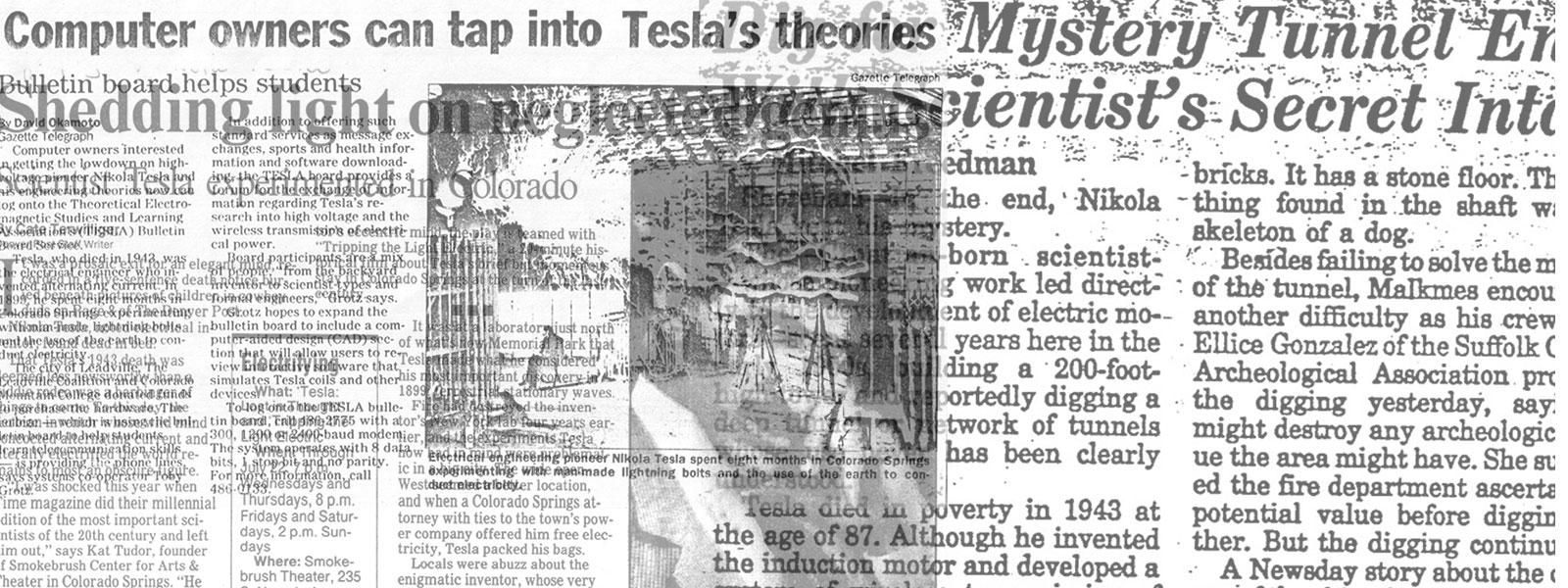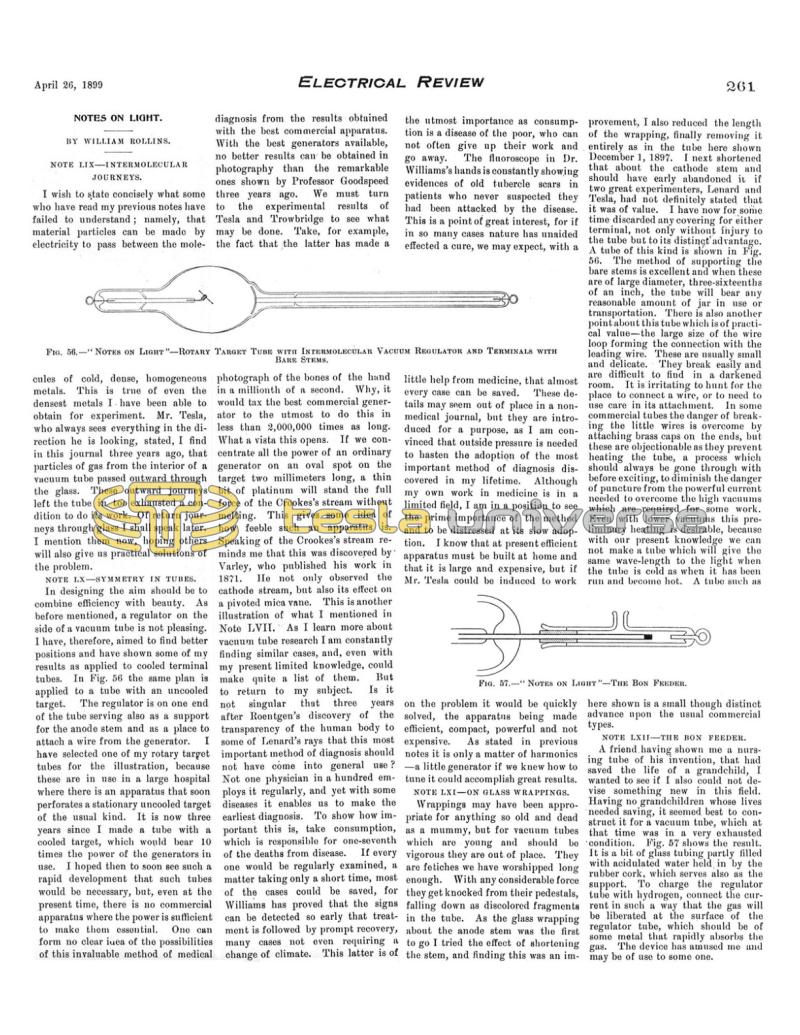
Nikola Tesla Articles
Notes on Light
Note LIX - Intermolecular Journeys
I wish to state concisely what some who have read my previous notes have failed to understand; namely, that material particles can be made by electricity to pass between the molecules of cold, dense, homogeneous metals. This is true of even the densest metals I have been able to obtain for experiment. Mr. Tesla, who always sees everything in the direction he is looking, stated, I find in this journal three years ago, that particles of gas from the interior of a vacuum tube passed outward through the glass. These outward journeys left the tube in too exhausted a condition to do its work. Of return journeys through glass I shall speak later. I mention them now, hoping others will also give us practical solutions of the problem.
NOTE LX - Symmetry in Tubes.
In designing the aim should be to combine efficiency with beauty. As before mentioned, a regulator on the side of a vacuum tube is not pleasing. I have, therefore, aimed to find better positions and have shown some of my results as applied to cooled terminal tubes. In Fig. 56 the same plan is applied to a tube with an uncooled target. The regulator is on one end of the tube serving also as a support for the anode stem and as a place to attach a wire from the generator. I have selected one of my rotary target tubes for the illustration, because these are in use in a large hospital where there is an apparatus that soon perforates a stationary uncooled target of the usual kind. It is now three years since I made a tube with a cooled target, which would bear 10 times the power of the generators in use. I hoped then to soon see such a rapid development that such tubes would be necessary, but, even at the present time, there is no commercial apparatus where the power is sufficient to make thorn essential. One can form no clear idea of the possibilities of this invaluable method of medical diagnosis from the results obtained with the best commercial apparatus. With the best generators available, no better results can be obtained in photography than the remarkable ones shown by Professor Goodspeed three years ago. We must turn to the experimental results of Tesla and Trowbridge to see what may be done. Take, for example, the fact that the latter has made a photograph of the bones of the hand in a millionth of a second. Why, it would tax the best commercial generator to the utmost to do this in less than 2,000,000 times as long. What a vista this opens. If we concentrate all the power of an ordinary generator on an oval spot on the target two millimeters long, a thin bit of platinum will stand the full force of the Crookes’s stream without melting. This gives some idea of how feeble such an apparatus is. Speaking of the Crookes’s stream reminds me that this was discovered by Varley, who published his work in 1871. He not only observed the cathode stream, but also its effect on a pivoted mica vane. This is another illustration of what I mentioned in Note LVII. As I learn more about vacuum tube research I am constantly finding similar cases, and, even with my present limited knowledge, could make quite a list of them. But to return to my subject. Is it not singular that three years after Roentgen’s discovery of the transparency of the human body to some of Lenard’s rays that this most important method of diagnosis should not have come into general use ? Not one physician in a hundred employs it regularly, and yet with some diseases it enables us to make the earliest diagnosis. To show how important this is, take consumption, which is responsible for one-seventh of the deaths from disease. If every one would be regularly examined, a matter taking only a short time, most of the cases could be saved, for Williams has proved that the signs can be detected so early that treatment is followed by prompt recovery, many cases not even requiring a change of climate. This latter is of the utmost importance as consumption is a disease of the poor, who can not often give up their work and go away. The fluoroscope in Dr. Williams’s hands is constantly showing evidences of old tubercle scars in patients who never suspected they had been attacked by the disease. This is a point of great interest, for if in so many cases nature has unaided effected a cure, we may expect, with a little help from medicine, that almost every case can be saved. These details may seem out of place in a nonmedical journal, but they are introduced for a purpose, as I am convinced that outside pressure is needed to hasten the adoption of the most important method of diagnosis discovered in my lifetime. Although my own work in medicine is in a limited field, I am in a position to see the prime importance of the method and to be distressed at its slow adoption. I know that at present efficient apparatus must be built at home and that it is large and expensive, but if Mr. Tesla could be induced to work on the problem it would be quickly solved, the apparatus being made efficient, compact, powerful and not expensive. As stated in previous notes it is only a matter of harmonics - a little generator if we knew how to tune it could accomplish great results.
NOTE LXI - ON GLASS WRAPPINGS
Wrappings may have been appropriate for anything so old and dead as a mummy, but for vacuum tubes which are young and should be vigorous they are out of place. They are fetiches we have worshipped long enough. With any considerable force they get knocked from their pedestals, falling down as discolored fragments in the tube. As the glass wrapping about the anode stem was the first to go I tried the effect of shortening the stem, and finding this was an improvement, I also reduced the length of the wrapping, finally removing it entirely as in the tube here shown December 1, 1897. I next shortened that about the cathode stem and should have early abandoned it if two great experimenters, Lenard and Tesla, had not definitely stated that it was of value. I have now for some time discarded any covering for either terminal, not only without injury to the tube but to its distinct advantage. A tube of this kind is shown in Fig. 50. The method of supporting the bare stems is excellent and when these are of large diameter, three-sixteenths of an inch, the tube will bear any reasonable amount of jar in use or transportation. There is also another point about this tube which is of practical value - the large size of the wire loop forming the connection with the leading wire. These are usually small and delicate. They break easily and are difficult to find in a darkened room. It is irritating to hunt for the place to connect a wire, or to need to use care in its attachment. In some commercial tubes the danger of breaking the little wires is overcome by attaching brass caps on the ends, but these are objectionable as they prevent heating the tube, a process which should always be gone through with before exciting, to diminish the danger of puncture from the powerful current needed to overcome the high vacuums which are required for some work. Even with lower vacuums this preliminary heating is desirable, because with our present knowledge we can not make a tube which will give the same wave-length to the light when the tube is cold as when it has been run and become hot. A tube such as here shown is a small though distinct advance upon the usual commercial types.
NOTE LXII - THE BON FEEDER
A friend having shown me a nursing tube of his invention, that had saved the life of a grandchild, I wanted to see if I also could not devise something new in this field. Having no grandchildren whose lives needed saving, it seemed best to construct it for a vacuum tube, which at that time was in a very exhausted condition. Fig. 57 shows the result. It is a bit of glass tubing partly filled with acidulated water held in by the rubber cork, which serves also as the support. To charge the regulator tube with hydrogen, connect the current in such a way that the gas will be liberated at the surface of the regulator tube, which should be of some metal that rapidly absorbs the gas. The device has amused me and may be of use to some one.


